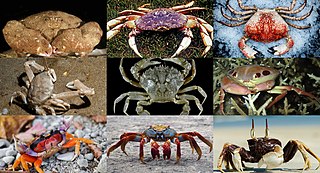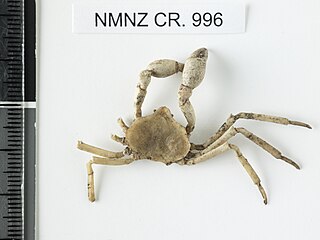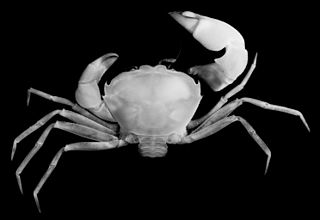
Crabs are decapod crustaceans of the infraorder Brachyura, which typically have a very short projecting "tail" (abdomen), usually hidden entirely under the thorax. They live in all the world's oceans, in freshwater, and on land, are generally covered with a thick exoskeleton, and have a single pair of pincers on each arm. They first appeared during the Jurassic Period.

Hymenosomatidae is a family of crabs with some 110 described species in 24 genera. The following genera are placed in the Hymenosomatidae:

Tuerkayana hirtipes is a species of terrestrial crab.
Hexapus is a genus of crabs in the family Hexapodidae. It contains only three extant species found in the Indo-West Pacific. They inhabit the intertidal and subtidal areas of shorelines.

Latreilliidae is a small family of crabs. They are relatively small, long-legged crabs found on soft bottoms at depths of up 700 metres (2,300 ft) in mostly tropical and subtemperate waters around the world. Their carapace is very small and doesn’t cover the bases of their legs, which protrude from the cephalothorax in a spider-like manner. The family and its type genus are named after Pierre André Latreille. The oldest known fossils from the Latreillidae have been dated to the middle of the Cretaceous period. It comprises seven extant species.
Tiwaripotamon vietnamicum is a species of crab. Originally described as a species of Geothelphusa, it is now treated as part of the genus Tiwaripotamon, although it has also been suggested as a member of Hainanpotamon. It is only known from a single locality in Cúc Phương National Park, Ninh Bình Province, Vietnam.

Amarinus lacustris is a species of freshwater crab from Australia, New Zealand and nearby islands, where it lives in water of various salinities. It grows up to 10 mm (0.4 in) wide, with an H-shaped groove on its back. It is an omnivore and is eaten by crayfish and fish. It was first discovered in Lake Pupuke, near Auckland, and is the only freshwater crab in New Zealand.

Karstarma is a genus of karst-dwelling crabs formerly included in Sesarmoides.
Hainanpotamon is a genus of freshwater crabs, containing the following species:

Cancrocaeca xenomorpha is a species of troglobitic (cave-dwelling) freshwater crab from Sulawesi, the only species in the monotypic genus Cancrocaeca. It has been described as the world's "most highly cave-adapted species of crab".

Elamena is a genus of crab, containing the following species:

Geosesarma dennerle is a species of small land-living crabs found on Java, Indonesia.

Christmaplacidae is a family of crab in the superfamily Pseudozioidea containing the species Christmaplax mirabilis from Christmas Island, Australia, and Harryplax severus from Guam.

Latreillia elegans is a species of crab belonging to the family Latreilliidae. This family of crabs is identified by their appearance as small, long-legged crabs. The species belongs to the genus Latreillia which has only five identified species: L. elegans, L. metanesa, L. williamsi, L.valida, and L. pennifera. It was previously thought that L.elegans and L.mannengi were two separate species, but it has since been revealed that the two species are synonymous. All the thought to be differences between L.elegans and L.mannengi were in actuality overlaps. The L. mannengi is simply referring to the close relative to the species of L. elegans found in the western Atlantic.

Nanhaipotamon is a genus of freshwater crabs, in the subfamily Potamiscinae, found in southern China and Taiwan. As of 2018, 18 species have been described. The genus is named after the South China Sea, for it occurs mostly in coastal areas. The genus was first described by R. Bott in 1968 as Isolapotamon (Nanhaipotamon), i.e., a subgenus of Isolapotamon.
Leptuca subcylindrica, commonly known as the Laguna Madre fiddler crab or the puffed fiddler crab, is a sparsely-studied species of fiddler crab native to southern Texas and northeastern Mexico in the Gulf of Mexico.
Leptuca batuenta, commonly known as the beating fiddler crab, is a species of fiddler crab native to the tropical eastern Pacific, from El Salvador to northern Peru.
Leptuca saltitanta, commonly known as the energetic fiddler crab, is a species of fiddler crab native to the eastern Pacific coasts, from El Salvador in Central America to Colombia in South America.
Leptuca terpsichores, commonly known as the dancing fiddler crab, is a species of fiddler crab native to the eastern Pacific coast of the Americas, from Nicaragua to Peru.

Limnopilos naiyanetri, commonly referred to as the Thai micro crab or pill-box crab, is a freshwater hymenosomatid crab endemic to Thailand. Its presence has only been confirmed in the Tha Chin River. The species was described in 1991 and represents the type species of Limnopilos. The Thai micro crab was first introduced to the aquarium hobby in 2008 when it was imported to Germany by the tropical fish importer Aquarium Glaser GmbH, and has slowly grown in popularity with aquarium hobbyists. It remains a relatively rare species on the market and detailed information on the husbandry of this species is scarce.














